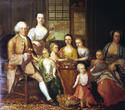 Until the Union of the Crowns in 1603 the Scottish Court in Edinburgh, where a French influence prevailed, was the centre of fashion. Although rich silks and velvets were stylish these were imported and only worn by the wealthiest on formal occasions. The inhabitants of Glasgow, a more rural town less fashionable than either Edinburgh or London, would have worn simpler garments mainly of coarse homespun wool and linen, often undyed.
Until the Union of the Crowns in 1603 the Scottish Court in Edinburgh, where a French influence prevailed, was the centre of fashion. Although rich silks and velvets were stylish these were imported and only worn by the wealthiest on formal occasions. The inhabitants of Glasgow, a more rural town less fashionable than either Edinburgh or London, would have worn simpler garments mainly of coarse homespun wool and linen, often undyed.
 In the late 16th century men wore a doublet and breeches with shanks (stockings), leather shoes and a distinctive blue or russet coloured cap called a bonnet. Women wore a cloth gown with long gathered skirt over a coarse linen shift. Leather shoes were cheap and readily available, although throughout this period clothing was expensive and, until the 18th century, servants relied on cast-offs from employers and clothing often formed part of their wages.
In the late 16th century men wore a doublet and breeches with shanks (stockings), leather shoes and a distinctive blue or russet coloured cap called a bonnet. Women wore a cloth gown with long gathered skirt over a coarse linen shift. Leather shoes were cheap and readily available, although throughout this period clothing was expensive and, until the 18th century, servants relied on cast-offs from employers and clothing often formed part of their wages.
 After James VI's court moved to London, fashions became increasingly English, although Daniel Defoe visiting Glasgow in 1723 commented on the plaid which was peculiar to Scotland and continued to be worn by women. However by the mid 18th century fashionable clothes were in greater evidence in the city. Printed linens were produced locally as was good quality striped muslin used for women's aprons and head coverings and silks and lace were bought from London. However the Glasgow tobacco lords were perhaps the most distinctive and flamboyant inhabitants in their scarlet cloaks, curled wigs, cocked hats and carrying long gold-headed canes.
After James VI's court moved to London, fashions became increasingly English, although Daniel Defoe visiting Glasgow in 1723 commented on the plaid which was peculiar to Scotland and continued to be worn by women. However by the mid 18th century fashionable clothes were in greater evidence in the city. Printed linens were produced locally as was good quality striped muslin used for women's aprons and head coverings and silks and lace were bought from London. However the Glasgow tobacco lords were perhaps the most distinctive and flamboyant inhabitants in their scarlet cloaks, curled wigs, cocked hats and carrying long gold-headed canes.